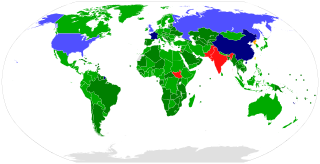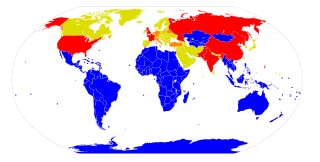
The International Atomic Energy Agency (IAEA) is an intergovernmental organization that seeks to promote the peaceful use of nuclear energy and to inhibit its use for any military purpose, including nuclear weapons. It was established in 1957 as an autonomous organization within the United Nations system; though governed by its own founding treaty, the organization reports to both the General Assembly and the Security Council of the United Nations, and is headquartered at the UN Office at Vienna, Austria.

The Treaty on the Non-Proliferation of Nuclear Weapons, commonly known as the Non-Proliferation Treaty or NPT, is an international treaty whose objective is to prevent the spread of nuclear weapons and weapons technology, to promote cooperation in the peaceful uses of nuclear energy, and to further the goal of achieving nuclear disarmament and general and complete disarmament. Between 1965 and 1968, the treaty was negotiated by the Eighteen Nation Committee on Disarmament, a United Nations-sponsored organization based in Geneva, Switzerland.

Nuclear proliferation is the spread of nuclear weapons, fissionable material, and weapons-applicable nuclear technology and information to nations not recognized as "Nuclear Weapon States" by the Treaty on the Non-Proliferation of Nuclear Weapons, commonly known as the Non-Proliferation Treaty or NPT. Proliferation has been opposed by many nations with and without nuclear weapons, as governments fear that more countries with nuclear weapons will increase the possibility of nuclear warfare, de-stabilize international or regional relations, or infringe upon the national sovereignty of nation states.

The Treaty of Tlatelolco is the conventional name given to the Treaty for the Prohibition of Nuclear Weapons in Latin America and the Caribbean. It is embodied in the OPANAL. Signed in 1967, it was the first treaty of its kind covering a populated area of the world, but now around 40% of the world's population live in a Nuclear-weapon-free zone.
The Vienna Convention on Civil Liability for Nuclear Damage is a 1963 treaty that governs issues of liability in cases of nuclear accident. It was concluded at Vienna on 21 May 1963 and entered into force on 12 November 1977. The convention has been amended by a 1997 protocol, in force since 4 October 2003. The depository is the International Atomic Energy Agency.

The African Nuclear-Weapon-Free Zone Treaty, also known as the Treaty of Pelindaba, establishes a Nuclear-Weapon-Free Zone in Africa. The treaty was signed in 1996 and came into effect with the 28th ratification on 15 July 2009.

Yukiya Amano was a Japanese diplomat and the Director General of the International Atomic Energy Agency (IAEA). Amano previously served as an international civil servant for the United Nations and its subdivisions.
The Nuclear Terrorism Convention is a 2005 United Nations treaty designed to criminalize acts of nuclear terrorism and to promote police and judicial cooperation to prevent, investigate and punish those acts. As of February 2021, the convention has 115 signatories and 118 state parties, including the nuclear powers China, France, India, Russia, the United Kingdom, and the United States. Most recently, Saint Kitts and Nevis acceded to the convention on 7 May 2022.
The 2010 Review Conference for the Treaty on the Non-Proliferation of Nuclear Weapons (NPT) was held at United Nations Headquarters in New York City from 3 to 28 May 2010. The President of the Review Conference is Ambassador Libran N. Cabactulan of the Philippines. UN Secretary-General Ban Ki-moon used the opening of the conference to note that "sixty five years later, the world still lives under the nuclear shadow".

The member states of the International Atomic Energy Agency (IAEA) are those states which have joined the international organization that seeks to promote the peaceful use of nuclear energy, and to inhibit its use for any military purpose, including nuclear weapons. The IAEA was established as an autonomous organization on 29 July 1957. Though established independently of the United Nations through its own international treaty, the IAEA Statute, the IAEA reports to both the UN General Assembly and Security Council. During 1956, an IAEA Statute Conference was held to draft the founding documents for the IAEA, and the IAEA Statute was completed at a conference in 1957.
The Convention on the Safety of United Nations and Associated Personnel is a United Nations treaty that has the goal of protecting United Nations peacekeepers and other UN personnel.
The Convention for the Suppression of Unlawful Acts against the Safety of Civil Aviation is a multilateral treaty by which states agree to prohibit and punish behaviour which may threaten the safety of civil aviation.
The Convention on Early Notification of a Nuclear Accident is a 1986 International Atomic Energy Agency (IAEA) treaty whereby states have agreed to provide notification of any nuclear accident that occur within its jurisdiction that could affect other states. It, along with the Convention on Assistance in the Case of a Nuclear Accident or Radiological Emergency, was adopted in direct response to the April 1986 Chernobyl disaster.
The Convention on Assistance in the Case of a Nuclear Accident or Radiological Emergency is a 1986 treaty of the International Atomic Energy Agency (IAEA) whereby states have agreed to provide notification to the IAEA of any assistance that they can provide in the case of a nuclear accident that occurs in another state that has ratified the treaty. Along with the Convention on Early Notification of a Nuclear Accident, it was adopted in direct response to the April 1986 Chernobyl disaster.
The Joint Convention on the Safety of Spent Fuel Management and on the Safety of Radioactive Waste Management is a 1997 International Atomic Energy Agency (IAEA) treaty. It is the first treaty to address radioactive waste management on a global scale.
Material unaccounted for (MUF), in the context of nuclear material, refers to any discrepancy between a nuclear-weapons state's physical inventory of nuclear material, and the book inventory. The difference can be either a positive discrepancy or a negative discrepancy. Nuclear accounting discrepancies are commonplace and inevitable due to the problem of accurately measuring nuclear materials. This problem of inaccurate measurement provides a potential loophole for diversion of nuclear materials for weapons production. In a large plant, even a tiny percentage of the annual through-put of nuclear material will suffice to build one or more nuclear weapons.

The collapse of the Soviet Union made Kazakhstan, the fourth-largest nuclear power in the world, leading to its rapid denuclearization. Formally known as the Kazakh Autonomous Soviet Socialist Republic, the former republic had a considerably large nuclear infrastructure due to its reliance on civilian nuclear programs as a means to develop its economy. The nuclear infrastructure and economy of Kazakhstan heavily depended on the cooperation between their country and Russia since its inception as an independent country.